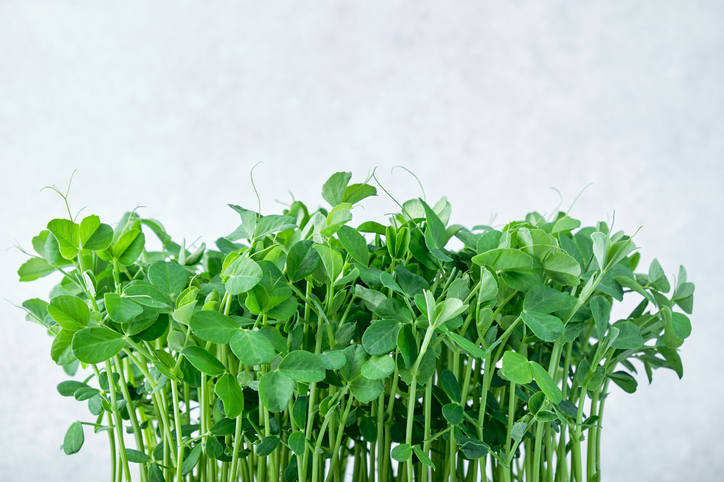Pea microgreens are those young seedlings that can be obtained from the same peas obtained from the pods of the plants.
It is one of the most widely accepted microgreens with a neutral flavor, ideal for incorporating sweet or savory preparations.
It is important to note that not all types of peas are suitable for germination and consumption as micro-vegetables, as they may contain neurotoxins. The most recommended species are Chinese peas and sugar snap peas, as they are not only healthier but also sweeter.
Like other types of microgreens, pea microgreens provide many nutrients. Each serving of approximately 100 grams offers 8 grams of carbohydrates, 3 grams of fiber, 2 grams of protein, 50% of the RDA of vitamin C, and 10% of the RDA of iron, calcium, and vitamin A. They are low in calories and have no cholesterol.
Thanks to their exceptional supply of vitamin C and iron, pea microgreens provide us with the following benefits:
Strengthen the immune system: The contribution of vitamin C helps the production of white blood cells, which are responsible for fighting infections and diseases.
Improve iron absorption: Vitamin C can help improve iron absorption from food, which is especially beneficial for people who are iron deficient or anemic. Pea microgreens are ideal for combining with iron-rich foods such as lentils, green vegetables, whole grains, etc.
Thanks to their additional iron supply, they are one of the foods with the best bioavailability of this mineral. This is why they are recommended for vegetarians and vegans to replace vegetable sources.
Protect against cardiovascular diseases: Vitamin C’s antioxidant function helps maintain the body’s redox balance, preventing cholesterol particles from oxidizing and depositing on the arterial wall. In this way, heart attacks and strokes are prevented.
Maintain healthy skin: Vitamin C helps the production of collagen, a protein essential for skin health and other connective tissues.
Combat fatigue states: Thanks to the contribution of iron, pea microgreens help the correct transport and supply of oxygen to the cells. This helps to increase energy and reduce fatigue.
Improve cognitive function: The iron in pea microgreens is essential for cognitive function and brain development. Low iron levels can cause mental problems, such as inattention.
Finally, pea microgreens also provide a good dose of phytoestrogens, compounds with mild hormonal activity that have been shown to reduce the risk of cardiovascular disease and breast cancer. Phytoestrogens also have excellent anti-inflammatory action, which are enhanced by the action of flavonoids, polyphenols with antioxidant and anti-inflammatory activity.
All this is in addition to the superb contribution of fiber provided by pea microgreens, which is essential for maintaining a healthy intestinal microbiota and promoting proper motility and nutrient absorption.
Pea microgreens are also low in calories and can be added to salads or other dishes to add bulk to preparations for people who want to reduce body fat.
This is in addition to their fiber content, which helps control hunger between meals by providing satiety.
References
Elstrott, B., Khan, L., Olson, S., Raghunathan, V., DeLoughery, T., & Shatzel, J. J. (2020). The role of iron repletion in adult iron deficiency anemia and other diseases. European Journal of Haematology, 104(3), 153–161. https://doi.org/10.1111/ejh.13345
Ferreres, F., Esteban, E., Carpena-Ruiz, R., Jiménez, M. A., & Tomás-Barberán, F. A. (1995). Acylated flavonol sophorotriosides from pea shoots. Phytochemistry, 39(6), 1443–1446. https://doi.org/10.1016/0031-9422(95)00137-v
Hemilä, H. (2017). Vitamin C and infections. Nutrients, 9(4), 339. https://doi.org/10.3390/nu9040339
Padayatty, S. J., Katz, A., Wang, Y., Eck, P., Kwon, O., Lee, J.-H., Chen, S., Corpe, C., Dutta, A., Dutta, S. K., & Levine, M. (2003). Vitamin C as an antioxidant: evaluation of its role in disease prevention. Journal of the American College of Nutrition, 22(1), 18–35. https://doi.org/10.1080/07315724.2003.10719272
Pullar, J., Carr, A., & Vissers, M. (2017). The roles of vitamin C in skin health. Nutrients, 9(8), 866. https://doi.org/10.3390/nu9080866
Santos, J., Herrero, M., Mendiola, J. A., Oliva-Teles, M. T., Ibáñez, E., Delerue-Matos, C., & Oliveira, M. B. P. P. (2014). Assessment of nutritional and metabolic profiles of pea shoots: The new ready-to-eat baby-leaf vegetable. Food Research International (Ottawa, Ont.), 58, 105–111. https://doi.org/10.1016/j.foodres.2014.01.062
Shakoor, H., Feehan, J., Al Dhaheri, A. S., Ali, H. I., Platat, C., Ismail, L. C., Apostolopoulos, V., & Stojanovska, L. (2021). Immune-boosting role of vitamins D, C, E, zinc, selenium and omega-3 fatty acids: Could they help against COVID-19? Maturitas, 143, 1–9. https://doi.org/10.1016/j.maturitas.2020.08.003
(N.d.). Isu.edu. Retrieved April 28, 2023, from https://www.isu.edu/media/libraries/rural-health/microgreens/Microgreen-Nutritional-Profile.pdf
Disclaimer
The information provided in this article is for educational and informational purposes only and is not intended as medical advice. It is not a substitute for professional medical advice, diagnosis, or treatment. Always seek the advice of a qualified healthcare provider with any questions you may have regarding a medical condition. The author and publisher of this article are not responsible for any adverse effects or consequences resulting from the use of any suggestions, preparations, or procedures described in this article.






 Become a Reseller
Become a Reseller













